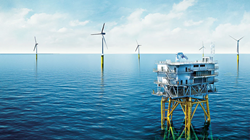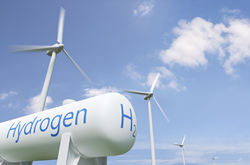3 min read
Global Initiatives and the Path to a Sustainable Energy Future
Jee Ltd
Dec 20, 2023 10:40:48 AM

As the world strives to transition to a low-carbon energy future, offshore wind and hydrogen production are emerging as promising solutions to meet the growing demand for clean energy. Offshore wind has the potential to generate vast amounts of renewable electricity, while hydrogen can serve as a versatile and carbon-free energy carrier. This blog will explore the potential of offshore wind hydrogen production and highlight global initiatives that are driving progress in this exciting field.
The Offshore Wind-Hydrogen Connection
Offshore wind farms can generate large quantities of clean electricity due to the abundant and consistent wind resources available at sea. By coupling offshore wind farms with electrolysers - devices that use electricity to split water into hydrogen and oxygen - it is possible to produce green hydrogen from renewable energy sources.
This approach offers several advantages:
- Overcoming intermittency: The intermittent nature of wind energy can be addressed by converting excess electricity into hydrogen during periods of low demand. This hydrogen can then be stored and used later, providing a flexible and efficient energy storage solution.
- Decarbonisation of multiple sectors: Hydrogen can be utilised in various sectors, including transportation, industry, and power generation, offering a pathway to decarbonise these sectors and reduce global greenhouse gas emissions.
- Grid integration: Offshore wind-hydrogen production can help to integrate renewable energy sources into the power grid by providing a stable and flexible supply of clean energy.

Global Initiatives in Offshore Wind Hydrogen Production
Several countries and regions have recognised the potential of offshore wind hydrogen production and have launched ambitious initiatives to develop and deploy these technologies:
- European Union: The EU has been a global leader in offshore wind and hydrogen development, with several projects underway:
- The HyWind project in the Netherlands is an innovative offshore wind-hydrogen pilot that aims to demonstrate the feasibility of producing green hydrogen from offshore wind energy.
- The OYSTER project, a collaboration between the UK, Denmark, and the Netherlands, aims to develop and deploy a novel electrolyser system for offshore wind farms, integrating the electrolyser directly into the wind turbine structure.
- The European Commission's Green Deal includes ambitious targets for offshore wind capacity and hydrogen production, with plans to increase offshore wind capacity to 300 GW by 2050 and produce up to 10 million tonnes of renewable hydrogen by 2030.
- United States: The US has recently made significant strides in offshore wind development, with the Biden administration setting a goal of deploying 30 GW of offshore wind capacity by 2030. In addition, the Department of Energy has launched the H2@Scale initiative, which aims to advance hydrogen production, storage, and utilisation technologies, including offshore wind hydrogen production.
- Australia: The Australian Renewable Energy Agency (ARENA) has funded a project to explore the feasibility of producing hydrogen from offshore wind energy. The project, led by the Australian Offshore Wind Energy Research Association (AOWERA), aims to identify suitable sites for offshore wind-hydrogen production and assess the technical and economic viability of such projects.
- China: As the world's largest producer of wind power, China has significant potential for offshore wind hydrogen production. The country has set ambitious targets for both offshore wind and hydrogen development, with plans to install 52 GW of offshore wind capacity by 2030 and produce 1 million tonnes of green hydrogen by 2025.
Challenges and Opportunities
While the potential of offshore wind hydrogen production is immense, several challenges must be addressed to fully realise this potential:
- Technological advancements: Improvements in electrolyser technologies, wind turbine designs, and hydrogen storage solutions are needed to increase efficiency and reduce costs.
- Infrastructure development: The expansion of offshore wind farms and hydrogen transportation and distribution infrastructure is critical to support the widespread adoption of offshore wind hydrogen production.
- Policy support: Governments must establish supportive policies and regulatory frameworks that encourage investment in offshore wind hydrogen production technologies and infrastructure development.
- Public awareness and acceptance: Effective communication, education, and public engagement are crucial to promote the benefits of offshore wind hydrogen production and increase public acceptance of these projects.
Despite these challenges, there are significant opportunities for growth and innovation in the offshore wind hydrogen production sector:
- Collaboration and partnerships: Cooperation between governments, industry stakeholders, research institutions, and local communities can help drive innovation and accelerate the deployment of offshore wind hydrogen production technologies.
- Emerging markets: Developing regions, such as Africa, Southeast Asia, and South America, hold significant potential for offshore wind hydrogen production. Investments in these areas can contribute to sustainable development while reducing dependence on fossil fuels.
- New business models: The growth of the offshore wind hydrogen production sector presents opportunities for new business models, such as hydrogen production as a service and integrated energy systems that combine offshore wind farms with hydrogen production facilities.
- Job creation and economic growth: The development and deployment of offshore wind hydrogen production technologies can create jobs and stimulate economic growth in regions with strong offshore wind resources.
Conclusion
Offshore wind hydrogen production has the potential to play a significant role in the global transition to a sustainable and low-carbon energy future. By harnessing the power of offshore wind to produce green hydrogen, we can overcome the challenges associated with renewable energy intermittency and decarbonise multiple sectors of the economy. Global initiatives in offshore wind hydrogen production are already driving progress, and with continued innovation, collaboration, and support from policymakers, this promising technology can help pave the way to a cleaner, greener future.
Visit our Hydrogen page here.


-1.png)
%20(1).png)

